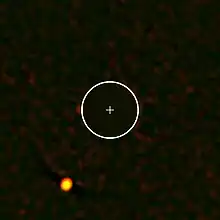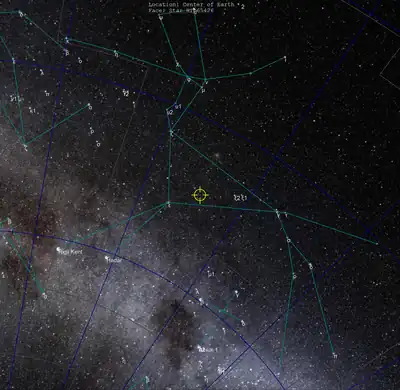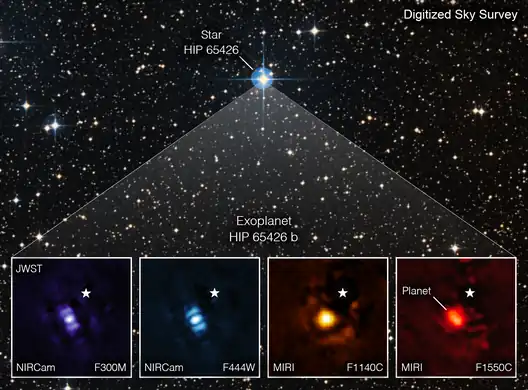HIP 65426 b
HIP 65426 b, formally named Najsakopajk,[3] is a super-Jupiter exoplanet orbiting the star HIP 65426. It was discovered on 6 July 2017 by the SPHERE consortium using the Spectro-Polarimetric High-Contrast Exoplanet Research (SPHERE) instrument belonging to the European Southern Observatory (ESO).[6][7] It is 385 light-years from Earth.[8] It is the first planet discovered by ESO's SPHERE instrument.[9]
 HIP 65426 b is on the lower left of the image, with the circle representing what Neptune's orbit would look like around the star HIP 65426, represented by a small cross. | |
| Discovery[1] | |
|---|---|
| Discovered by | SPHERE consortium[2] |
| Discovery date | 6 July 2017 |
| Direct imaging | |
| Designations | |
| Najsakopajk[3] | |
| Orbital characteristics | |
| 87+108 −31 au[4] | |
| Inclination | 100+15 −6 deg[4] |
| Physical characteristics | |
Mean radius | Atmospheric model: 0.92±0.04 RJ[4] Evolutionary model: 1.45±0.03 RJ[4] |
| Mass | 7.1±1.1 MJ[4] |
| 4.07±0.19 dex | |
| Temperature | Atmospheric model: 1667+25 −24 K[4] Evolutionary model: 1282+26 −31 K[4] |
Nomenclature
In August 2022, this planet and its host star were included among 20 systems to be named by the third NameExoWorlds project.[10] The approved names, proposed by a team from Mexico, were announced in June 2023. HIP 65426 b is named Najsakopajk and its host star is named Matza, after Zoque words for "Mother Earth" and for a star.[3]
Overview
The exoplanet HIP 65426 b orbits its host star HIP 65426, an A2V star with apparent magnitude 7.01 and a mass of 1.96±0.04 M☉.[11] This planetary system is located in the constellation Centaurus. The planet is around 14 million years old. However, it is not associated with a debris disk, despite its young age,[7][8] causing it to not fit current models for planetary formation.[12] It is around 92 AU from its parent star, with a possible dusty atmosphere.[13] It was discovered as part of the SHINE program, which aimed to find planetary systems around 600 new stars.[1]
In September 2022, HIP 65426 b became the first exoplanet directly observed by the James Webb Space Telescope.[14]
Planetary atmosphere
The spectrum taken in 2020 has indicated that HIP 65426 b is carbon-poor and oxygen-rich compared to Solar System gas giants.[5]
James Webb Space Telescope observation
In August 2022, a pre-print of the James Webb Space Telescope (JWST) observations was published. The JWST direct imaging observations between 2-16 μm of HIP 65426 b tightly constrained its bolometric luminosity to , which provides a robust mass constraint of 7.1±1.1 MJ. The atmospheric fitting of both temperature and radius are in disagreement with evolutionary models. The team also constrained the semi-major axis and the inclination of the planet, but the new JWST astrometry of the planet did not significantly improve the orbit of the planet, especially the eccentricity remains unconstrained.[4][15]
HIP 65426 b is the first exoplanet to be imaged by JWST and the first exoplanet to be detected beyond 5 μm. The observations demonstrate that the James Webb Space Telescope will exceed its nominal predicted performance by a factor of 10 and that it will be able to image 0.3 MJ planets at 100 au for main-sequence stars, Neptune and Uranus-mass objects at 100-200 au for M-dwarfs and Saturn-mass objects at 10 au for M-dwarfs. For α Cen A JWST might be able to push the limit to a 5 R🜨 planet at 0.5 to 2.5 au.[4]


References
- Chauvin, G.; Desidera, S.; Lagrange, A. -M.; Vigan, A.; Gratton, R.; Langlois, M.; Bonnefoy, M.; Beuzit, J. -L.; Feldt, M.; Mouillet, D.; Meyer, M.; Cheetham, A.; Biller, B.; Boccaletti, A.; d'Orazi, V.; Galicher, R.; Hagelberg, J.; Maire, A. -L.; Mesa, D.; Olofsson, J.; Samland, M.; Schmidt, T. O. B.; Sissa, E.; Bonavita, M.; Charnay, B.; Cudel, M.; Daemgen, S.; Delorme, P.; Janin-Potiron, P.; et al. (2017). "Discovery of a warm, dusty giant planet around HIP 65426". Astronomy and Astrophysics. 605: L9. arXiv:1707.01413. Bibcode:2017A&A...605L...9C. doi:10.1051/0004-6361/201731152. S2CID 102344893.
- "Odd planetary system around fast-spinning star doesn't quite fit existing models of planet formation". www.sphere.osug.fr. Retrieved 2017-07-06.
- "2022 Approved Names". nameexoworlds.iau.org. IAU. Retrieved 7 June 2023.
- Carter, Aarynn L.; Hinkley, Sasha; Kammerer, Jens; Skemer, Andrew; Biller, Beth A.; Leisenring, Jarron M.; Millar-Blanchaer, Maxwell A.; Petrus, Simon; Stone, Jordan M.; Ward-Duong, Kimberly; Wang, Jason J.; Girard, Julien H.; Hines, Dean C.; Perrin, Marshall D.; Pueyo, Laurent (2022-08-31). "The JWST Early Release Science Program for Direct Observations of Exoplanetary Systems I: High Contrast Imaging of the Exoplanet HIP 65426 b from 2-16 μm". arXiv:2208.14990 [astro-ph.EP].
- Petrus, S.; Bonnefoy, M.; Chauvin, G.; Charnay, B.; Marleau, G.-D.; Gratton, R.; Lagrange, A.-M.; Rameau, J.; Mordasini, C.; Nowak, M.; Delorme, P.; Boccaletti, A.; Carlotti, A.; Houllé, M.; Vigan, A.; Allard, F.; Desidera, S.; d'Orazi, V.; Hoeijmakers, H. J.; Wyttenbach, A.; Lavie, B. (2021), "Medium-resolution spectrum of the exoplanet HIP 65426 B", Astronomy & Astrophysics, 648: A59, arXiv:2012.02798, Bibcode:2021A&A...648A..59P, doi:10.1051/0004-6361/202038914, S2CID 227347064
- "Scientists have found a planet that means everything they thought about planets isn't true". The Independent. 2017-07-08. Retrieved 2019-08-02.
- "Astronomers Directly Image Super-Jupiter around HIP 65426 | Astronomy | Sci-News.com". Breaking Science News | Sci-News.com. Retrieved 2019-08-02.
- "Holiday Special: Eight nights of Exoplanet Light". Exoplanet Exploration: Planets Beyond our Solar System. NASA. Retrieved 2019-08-03.
- "ESO's SPHERE Unveils its First Exoplanet". www.eso.org. Retrieved 2017-07-07.
- "List of ExoWorlds 2022". nameexoworlds.iau.org. IAU. 8 August 2022. Retrieved 27 August 2022.
- "The Extrasolar Planet Encyclopaedia — HIP 65426 b". Extrasolar Planets Encyclopaedia. Paris Observatory.
- "Odd planetary system around fast-spinning star doesn't quite fit existing models of planet formation". phys.org. Retrieved 2019-08-03.
- Johnson-Groh, Mara; July 12, 2017. "New exoplanet challenges formation models". Astronomy.com. Retrieved 2019-08-03.
- Fisher, Alise (2022-09-01). "NASA's Webb Takes Its First-Ever Direct Image of Distant World". NASA Blogs. NASA. Retrieved 2022-09-01.
- Carter, Aarynn L.; et al. (August 2022). "The JWST Early Release Science Program for Direct Observations of Exoplanetary Systems I: High Contrast Imaging of the Exoplanet HIP 65426 b from 2-16 μm". arXiv:2208.14990.